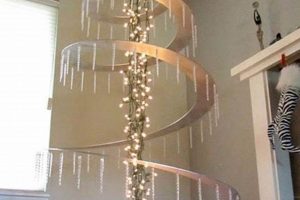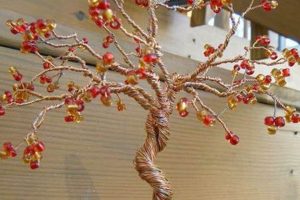The concept involves constructing a festive evergreen-shaped display for exterior spaces using self-sourced materials and handcrafted techniques. This often entails repurposing items like wooden pallets, branches, or even household recyclables to create a unique and personalized seasonal decoration for yards, porches, or gardens.
The practice offers a cost-effective and environmentally conscious alternative to purchasing commercially produced decorations. It promotes creative expression, allows for customized designs that reflect individual styles, and contributes to a more sustainable approach to holiday decorating. The activity also extends the holiday spirit into the community as such displays beautify neighborhoods and enhance the festive atmosphere.
Subsequent sections will explore specific construction methods, material suggestions, and design considerations for crafting durable and visually appealing outdoor holiday decorations. Detailed instructions and safety guidelines will be provided to ensure successful and enjoyable project completion.
Construction and Display Tips
Effective creation and presentation of exterior seasonal decorations necessitate careful planning and execution. The following guidelines promote structural integrity, visual appeal, and safety.
Tip 1: Material Selection: Prioritize weather-resistant components. Treated lumber, exterior-grade plywood, and naturally durable materials, such as cedar or redwood, withstand prolonged exposure to the elements.
Tip 2: Structural Integrity: Employ robust joinery techniques. Screws, bolts, and waterproof adhesives provide stronger connections than nails or staples, particularly in windy locations. Internal bracing reinforces the overall stability.
Tip 3: Illumination Considerations: Utilize outdoor-rated lighting fixtures. LED lights consume less energy and generate less heat than incandescent bulbs, reducing the risk of fire. Ensure proper wiring and grounding to prevent electrical hazards.
Tip 4: Secure Mounting: Anchor the structure firmly to the ground or a stable base. Weights, stakes, or permanent mounting hardware prevent tipping or displacement during inclement weather. Consider wind load and potential snow accumulation.
Tip 5: Design for Drainage: Incorporate drainage features to prevent water accumulation. Angled surfaces or strategically placed openings allow water to escape, minimizing the risk of rot or decay.
Tip 6: Visual Harmony: Integrate the decoration with the surrounding landscape. Choose colors and materials that complement the existing architecture and vegetation. Consider the scale and proportion relative to the outdoor space.
Tip 7: Safety Precautions: Inspect the structure regularly for signs of wear or damage. Promptly repair any deficiencies to prevent accidents. Keep pathways clear and free from obstructions.
Adhering to these guidelines enhances the longevity, aesthetics, and safety of your outdoor display, ensuring a festive and worry-free holiday season.
The concluding section will address maintenance procedures and storage recommendations for extending the lifespan of these decorative installations.
1. Material Durability
The longevity and structural integrity of a “diy christmas tree outdoor” are directly contingent upon the durability of the chosen materials. Premature degradation of components necessitates frequent repairs or complete reconstruction, negating the initial cost savings and environmental benefits associated with a do-it-yourself approach. Consequently, material selection is a paramount consideration in the planning and execution phases.
For instance, using untreated lumber for the frame will lead to rot and decay from moisture exposure. Similarly, fabrics that are not UV-resistant will fade and weaken under prolonged sunlight. Fasteners lacking corrosion resistance will rust and compromise the structural stability. Employing materials specifically designed for outdoor use, such as pressure-treated wood, exterior-grade plywood, weather-resistant fabrics, and stainless steel hardware, mitigates these risks. Examples of successful projects highlight the use of reclaimed materials sourced carefully to ensure structural soundness. The upfront investment in durable elements translates to long-term cost savings and reduced maintenance efforts.
In conclusion, prioritizing material durability in the construction of outdoor holiday displays is not merely a matter of aesthetic preference, but a practical imperative for ensuring structural stability, weather resistance, and overall longevity. The careful selection of appropriate components, considering their inherent properties and potential environmental stressors, is essential for a successful and sustainable creation.
2. Structural Stability
Structural stability is a fundamental requirement for any “diy christmas tree outdoor,” ensuring its ability to withstand environmental stressors and maintain its intended form throughout the holiday season. A lack of structural integrity poses safety risks and diminishes the aesthetic appeal of the display.
- Foundation and Base Design
The base of the structure dictates its overall stability. A wide, solid base, whether constructed from wood, metal, or a weighted material, prevents tipping. For taller installations, burying a portion of the base underground or anchoring it to a concrete footing provides enhanced resistance to wind forces. Inadequate base design leads to instability, particularly in exposed locations.
- Internal Framework and Support
The internal framework provides the primary support for the exterior form. Using durable materials like treated lumber or metal framing ensures the framework can bear the weight of decorations and resist bending or breaking. Proper joinery techniques, such as screwing and bolting rather than simply nailing, strengthen connections and distribute stress evenly. Insufficient internal support results in sagging, leaning, or collapse.
- Wind Load Resistance
Wind exerts significant force on outdoor structures. Designing for wind load involves minimizing the surface area exposed to the wind and incorporating features that allow wind to pass through the structure. This can be achieved through open lattice designs or strategically placed openings. Additionally, securing the structure to the ground or a stable anchor point prevents it from being blown over in high winds. Neglecting wind load considerations leads to structural failure during storms.
- Weight Distribution and Balance
Even weight distribution is essential for maintaining balance and preventing stress on specific parts of the structure. Distributing decorations evenly and avoiding excessive weight on one side prevents tipping and reduces the risk of structural failure. A well-balanced structure distributes stress evenly across the frame, enhancing its overall stability. Improper weight distribution compromises stability and increases the likelihood of collapse.
In summary, structural stability is not merely an aesthetic consideration but a crucial element for the safety and longevity of any “diy christmas tree outdoor.” A robust foundation, a well-engineered framework, and careful attention to wind load and weight distribution ensure that the structure remains upright and intact throughout the holiday season, even under challenging weather conditions. These stability features contribute significantly to the overall success and enjoyment of the seasonal decoration.
3. Weather Resistance
The capability to endure various atmospheric conditions is a critical determinant of the longevity and aesthetic appeal of a self-made outdoor seasonal display. Without adequate protection against the elements, a meticulously crafted decoration will rapidly deteriorate, diminishing its visual impact and potentially creating safety hazards.
- Material Selection for Longevity
The selection of materials directly dictates the ability of the structure to withstand weather. Materials such as untreated wood are susceptible to rot and decay, while non-UV-resistant fabrics fade and weaken under sunlight. The implementation of weather-resistant components, including treated lumber, exterior-grade plywood, and fabrics specifically designed for outdoor use, extends the lifespan of the decoration. Examples include cedar, redwood, and marine-grade paints, all proven to withstand exposure to moisture and temperature fluctuations.
- Protective Coatings and Finishes
The application of protective coatings and finishes provides an additional barrier against the elements. Exterior-grade paints, varnishes, and sealants prevent moisture penetration, minimizing the risk of rot and decay. UV-resistant coatings protect against fading and degradation caused by sunlight. Regularly reapplying these finishes maintains the protective barrier and extends the life of the display. Examples include applying a polyurethane coating to wooden components or using a fabric sealant on textile elements.
- Drainage and Moisture Management
Effective drainage systems are crucial for preventing water accumulation and subsequent damage. Incorporating drainage features, such as angled surfaces or strategically placed openings, allows water to escape, minimizing the risk of rot, mold, and structural degradation. Ensuring proper ventilation around the base of the structure promotes air circulation, further reducing moisture buildup. Examples include designing a base with drainage holes or elevating the display on a platform to allow airflow.
- Structural Design for Wind Resistance
The structural design significantly influences the ability of the display to withstand wind. Streamlined shapes and open lattice designs reduce wind resistance, minimizing the risk of toppling or structural failure. Securely anchoring the structure to the ground or a stable base prevents it from being blown over in high winds. Examples include using a wide base for stability or incorporating windbreaks to deflect gusts.
The factors related to weather resistance are not merely design elements but necessary features that determine the long-term viability of any “diy christmas tree outdoor.” Careful attention to material selection, protective coatings, drainage management, and structural design ensures that the creation maintains its aesthetic appeal and structural integrity throughout the holiday season, even in adverse weather conditions.
4. Visual Integration
Effective visual integration is a key determinant of a “diy christmas tree outdoor” displays success, impacting its aesthetic harmony with the surrounding environment and its overall contribution to seasonal ambiance. Achieving seamless visual integration necessitates careful consideration of several factors, ensuring the decoration complements its surroundings rather than appearing incongruous.
- Color Palette Coordination
The selection of colors for the seasonal display must align with the existing color scheme of the house and landscape. A harmonious color palette creates a cohesive aesthetic, whereas clashing colors can create visual dissonance. For example, a house with warm earth tones benefits from decorations incorporating natural greens, browns, and golds. Conversely, a house with cooler gray or blue tones might be better complemented by decorations with silvers, whites, and icy blues. A poorly chosen color palette can detract from the overall visual appeal of both the decoration and the surrounding property.
- Scale and Proportion Appropriateness
The size and scale of the seasonal display must be proportional to the size of the house and yard. An overly large decoration can overwhelm a small property, while an overly small decoration can be lost in a larger space. Maintaining proper proportions ensures that the display complements its surroundings without dominating them. For instance, a small townhouse might benefit from a modestly sized decoration, whereas a large estate can accommodate a more substantial display. Disproportionate sizing diminishes the aesthetic impact of the decoration and can create an unbalanced visual composition.
- Material and Texture Compatibility
The materials and textures used in the seasonal display must be compatible with the materials and textures of the surrounding landscape. Incorporating natural materials, such as wood, stone, and greenery, can create a seamless transition between the decoration and its environment. Contrasting textures, such as pairing smooth surfaces with rough surfaces, can add visual interest, but they must be used judiciously to avoid creating visual clutter. Using materials that clash with the surrounding landscape detracts from the overall aesthetic coherence.
- Style and Theme Consistency
The style and theme of the seasonal display must be consistent with the style of the house and yard. A modern house might benefit from a minimalist display with clean lines and geometric shapes, while a traditional house might be better complemented by a more ornate display with classic motifs. Maintaining consistency in style and theme ensures that the decoration feels like a natural extension of the property. A mismatched style or theme creates visual confusion and undermines the overall aesthetic impact.
Effective visual integration transforms a simple “diy christmas tree outdoor” into a harmonious element of the seasonal landscape. By carefully considering color palette, scale, materials, and style, creators ensure that their displays enhance the beauty of their surroundings and contribute positively to the overall festive atmosphere.
5. Illumination Safety
The integration of lighting into seasonal outdoor displays introduces significant electrical safety considerations. Improperly installed or maintained illumination poses risks of electric shock, fire, and property damage. Prioritizing electrical safety protocols is paramount when constructing and deploying a “diy christmas tree outdoor” display that incorporates lights. Electrical faults in wiring, substandard components, or exposure to weather elements can create hazardous conditions that threaten both property and individuals.
Real-world incidents demonstrate the potential consequences of neglecting illumination safety. Examples include fires ignited by overheated incandescent bulbs, electric shocks caused by frayed wiring, and property damage resulting from short circuits due to water intrusion. The use of Underwriters Laboratories (UL)-listed lights, ground fault circuit interrupters (GFCIs) for outdoor outlets, and regular inspections for damage or wear are practical measures to mitigate these risks. Furthermore, ensuring that all electrical connections are weatherproofed and that extension cords are rated for outdoor use minimizes the likelihood of hazardous conditions. Adherence to local electrical codes and regulations is essential for compliance and safety.
In summary, illumination safety is not merely an ancillary concern but a core component of responsible outdoor display creation. Addressing potential electrical hazards through the implementation of appropriate safety measures is crucial for ensuring a safe and enjoyable holiday season. Continuous diligence in inspection, maintenance, and adherence to safety guidelines are key to preventing accidents and protecting property from electrical hazards associated with seasonal outdoor lighting.
6. Scale Appropriateness
Scale appropriateness is a critical determinant of a “diy christmas tree outdoor”‘s overall visual success and contextual harmony. The dimensions of the constructed display must correspond proportionally to the surrounding environment, architectural features, and available space. A mismatch in scale diminishes aesthetic appeal, creating a visually jarring effect rather than a festive enhancement. The cause of an inappropriate scale often stems from a lack of pre-planning or a failure to accurately assess the dimensions of the intended display area. The importance of achieving scale appropriateness lies in its ability to create a balanced and pleasing visual composition, thereby maximizing the aesthetic impact of the outdoor decoration. For example, a towering tree placed in front of a modest bungalow overwhelms the structure and appears disproportionate. Conversely, a diminutive tree positioned in a sprawling front yard is visually lost and fails to make a significant statement.
The selection of materials, the complexity of the design, and the overall construction effort are all influenced by the scale of the project. A larger scale necessitates stronger structural support, more extensive lighting systems, and potentially, specialized equipment for installation. Smaller scale designs offer greater flexibility in material choices and allow for more intricate detailing. The practical application of scale appropriateness involves precise measurements of the intended display area, careful consideration of the viewing angles, and a realistic assessment of the available resources and construction capabilities. Digital modeling or scaled mock-ups can assist in visualizing the final product and ensuring that it aligns with the intended aesthetic goals.
In conclusion, scale appropriateness is not merely an aesthetic consideration but a fundamental design principle that dictates the visual impact and overall success of a “diy christmas tree outdoor.” Neglecting this aspect leads to unbalanced compositions and diminished aesthetic appeal. A well-proportioned display enhances the festive ambiance and complements the surrounding environment, contributing positively to the overall seasonal experience. While achieving accurate scale requires careful planning and execution, the resultant visual harmony justifies the effort, creating a captivating and memorable outdoor decoration. Addressing challenges related to scale often involves iterative design adjustments and a willingness to adapt the project to the constraints of the available space.
7. Anchoring Security
Anchoring security is a critical element in the successful deployment of any exterior holiday decoration, particularly a self-constructed tree. Without adequate anchoring, the structure is vulnerable to displacement or collapse due to wind, snow, or other environmental factors, posing potential safety hazards and property damage risks.
- Ground Anchoring Methods
Effective ground anchoring is essential for securing the base of the structure. Methods include driving stakes into the ground and attaching them to the base, burying a portion of the base underground, or using weighted anchors such as sandbags or concrete blocks. The choice of method depends on the soil type, the size and weight of the structure, and the expected wind conditions. Failure to adequately anchor the base can result in the structure tipping over or being blown away.
- Tethering Systems for Stability
Tethering systems provide additional support, especially for taller structures. This involves attaching ropes or cables to the structure and securing them to nearby trees, fences, or other stable objects. Turnbuckles or other tensioning devices can be used to adjust the tension and ensure that the structure remains upright and stable. Improperly installed tethering systems can create tripping hazards or fail to provide adequate support in high winds.
- Wind Load Considerations
Wind load refers to the force exerted by wind on the surface of the structure. Calculating the expected wind load is crucial for determining the appropriate anchoring method and the number of anchors required. Factors to consider include the size and shape of the structure, the prevailing wind direction, and the geographic location. Ignoring wind load considerations can lead to under-engineered anchoring systems that fail under stress.
- Material Compatibility and Durability
The materials used for anchoring must be compatible with the materials used to construct the tree and must be durable enough to withstand the elements. Using galvanized steel stakes and cables prevents corrosion and ensures long-term stability. Regularly inspecting the anchoring system for signs of wear or damage is essential for maintaining its effectiveness. Using substandard materials or neglecting maintenance can compromise the integrity of the anchoring system.
In conclusion, anchoring security is not merely an optional add-on but a necessary component of any “diy christmas tree outdoor” project. Selecting appropriate anchoring methods, accounting for wind load, and using durable materials ensures that the structure remains safely and securely in place throughout the holiday season, regardless of weather conditions. Proper anchoring protects property, prevents injuries, and allows the creators to enjoy their festive display without concern.
Frequently Asked Questions
The following addresses common inquiries regarding the construction, maintenance, and safety of exterior holiday installations.
Question 1: What constitutes a suitable foundation for an outdoor seasonal tree?
A stable foundation is crucial. Options include a wide, weighted base constructed from concrete, wood, or metal. In-ground anchoring with stakes or buried supports offers enhanced stability, particularly in areas prone to high winds.
Question 2: How can the risk of electrical hazards be minimized when incorporating lights?
The use of UL-listed outdoor-rated lights is mandatory. Ground fault circuit interrupters (GFCIs) should be utilized for all outdoor electrical outlets. Regular inspection of wiring and connections for damage is imperative.
Question 3: What materials offer optimal weather resistance for outdoor displays?
Treated lumber, exterior-grade plywood, and weather-resistant fabrics provide enhanced protection against moisture, sunlight, and temperature fluctuations. Protective coatings, such as marine-grade paints and sealants, further extend the lifespan of the structure.
Question 4: How does one accurately determine the appropriate scale for an outdoor decoration?
The scale should correspond proportionally to the size of the house, yard, and surrounding landscape. Overly large decorations can overwhelm smaller properties, while diminutive decorations may be lost in larger spaces. Accurate measurements and visual simulations aid in determining appropriate dimensions.
Question 5: What are effective strategies for preventing wind-related damage to outdoor trees?
Streamlined shapes, open lattice designs, and secure anchoring to the ground reduce wind resistance. Tethering systems, utilizing ropes or cables attached to nearby structures, provide additional support in high-wind conditions.
Question 6: How frequently should an outdoor seasonal display be inspected for maintenance purposes?
Regular inspections, ideally on a weekly basis, are recommended. Any signs of damage, wear, or instability should be promptly addressed. Protective coatings should be reapplied as needed to maintain weather resistance.
In summary, responsible planning, diligent execution, and consistent maintenance are essential for ensuring the safety, longevity, and aesthetic appeal of self-made outdoor decorations.
The subsequent section will provide resources and further reading materials for those seeking more detailed information on this topic.
Conclusion
This exploration of “diy christmas tree outdoor” underscored the importance of material selection, structural integrity, weather resistance, visual integration, illumination safety, scale appropriateness, and anchoring security. Each element contributes to the longevity, safety, and aesthetic success of the resulting seasonal decoration. The absence of any of these considerations can compromise the overall outcome.
The construction of such displays, therefore, demands meticulous planning and execution. The successful implementation provides not only a unique seasonal ambiance but also a demonstration of resourcefulness and commitment to safety. Future endeavors in this domain must continue to prioritize these critical factors to ensure both structural stability and the well-being of the surrounding environment.







